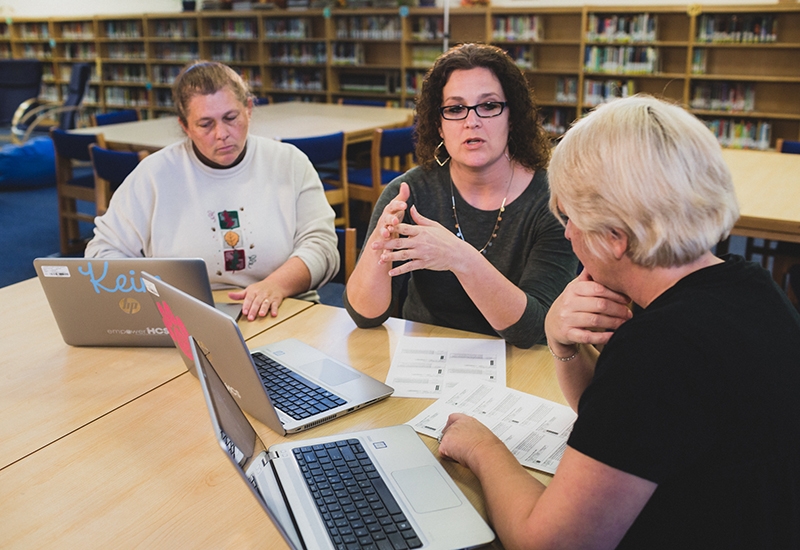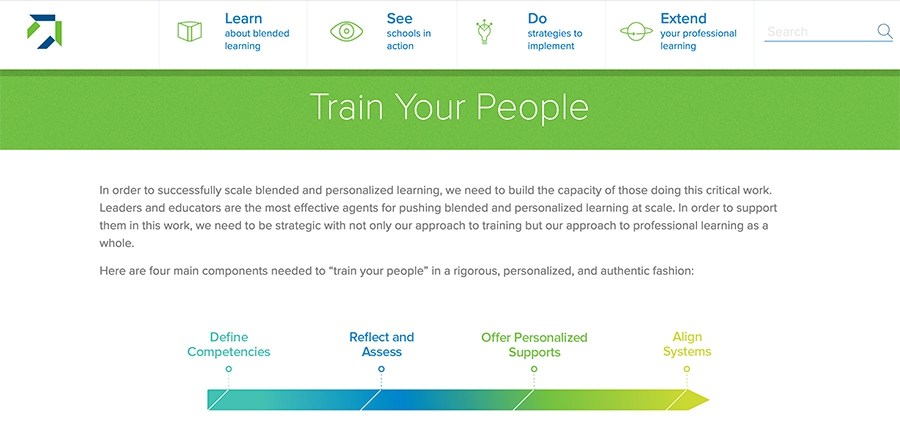Key Takeaways
- Educators will learn four key ways to implement effective professional development to support curating and creating high-quality instructional materials.
- Educators will understand how vital personalized professional development is to successful implementation of instructional materials like OER.
- Educators will explore concrete resources around competencies and personalized supports that can be used when leveraging OER to build high-quality curriculum.

What is the problem?
The lack of appropriate, high-quality professional development is one of the main barriers to effective implementation of Open Educational Resources (OER). Educators therefore need focused training on how to develop, design, and implement curriculum and instructional materials. Many schools and districts struggle to address this challenge due to a lack of expertise and knowledge, insufficient funds to support professional development, scarcity of coaching supports, and/or insufficient time. At the same time, we've found that leveraging OER as an opportunity for deep learning about curricular materials has allowed for some creative and powerful approaches to support professional development.
Educators and professional developers need to consider four main questions and their strategies for addressing each:
- How are you defining your competencies? (i.e., what does mastery look like?)
- How can educators reflect and assess their current mastery of instruction and curriculum design?
- How will you personalize educators’ supports to meet their needs?
- How are you ensuring that all of your systems are aligned to enable continued supports?
Why is it important?
Providing rich professional development experiences to meet educators where they are allow them to be more engaged and have authentic experiences to build on and learn from. The shift to high-quality OER can create confusion on how to best build, plan, and execute the content in classrooms, so by modeling these practices, educators can experience what this can look like in their classrooms. There is a wealth of already existing open resources, but it is essential for educators to understand how and why OER will support enhancing instruction to meet their students' needs, while also acknowledging that educators themselves have a wide variety of needs.
The research says...
Professional development must be "directly relevant and applicable to teachers’ classrooms, be differentiated to teachers’ individual needs, and build on teachers’ previous knowledge and experiences."
Effective professional development programs provide teachers with five critical elements:
- Collaborative learning
- Links between curriculum, assessment, and professional learning decisions in the context of teaching specific content
- Active learning
- Deeper knowledge of content and how to teach it
- Sustained learning over multiple days and weeks
How: Solution
The successful implementation and scaling of any initiative – including OER – requires building the capacity of the people doing the work. Leaders and educators should be strategic with not only their approach to specific training but also to professional learning as a whole. Four components to consider as you think about your teachers' professional development journeys include:
Define Competencies
Before you decide on an approach to supporting your educators, you need to identify and define critical competencies by asking yourself:
- What do my educators need to be successful?
- What does mastery of each competency look like in action?
When applying this to OER, those competencies can include various components, such as deep knowledge of subject standards and resource evaluation and curation skills. Educators need to master the content while also learning how to build resources to support that content, and how to design lessons to present that content in an effective and personalized way.
Reflect & Assess
Giving educators the opportunity to reflect and assess where they are in their personal mastery of competencies is especially important when supporting educators using OER, since they can be at very different levels of content mastery and may vary in their understanding of how to apply it. Some educators are new to OER, some have heard of it, and some could be "super users" that are very comfortable finding and adapting content to build coursework.
In order to find out where each educator is, either formally or informally, it is important to empower them to:
- Reflect on and assess themselves, using defined metrics for each competency.
- Identify strengths and gaps in their mastery and set goals for the future.
When exploring these strategies, ask yourself:
- How could this strategy enable me (or my educators) to reflect on current practices?
- What are the competencies I (or my educators) would be able to assess for mastery?
- How could I apply this strategy to my own school, district, and/or network?
Offer Personalized Systems
By modeling best practices and giving educators access to the content in a way that engages them, you are:
- Helping teachers experience personalized and competency-based learning as learners.
- Aligning to competencies with a focus on individual needs.
- Offering differentiated support through different modalities.
- Continually assessing learning, which will inspire your adult learners to do the same with their students.
When supporting educators to transition to using OER, there are additional personalized supports educators need along the way to not only feel successful but also learn and grow within the various competencies.
When exploring these strategies, ask yourself these key questions:
- How do you envision your teachers engaging with their professional development?
- How can teachers demonstrate their mastery of different competencies?
- What does continuous support look like?
Align Systems
All of this work supporting individual educators to build critical competencies must be aligned with the bigger human resource systems and structures. Central human capital management systems and processes are interrelated, so each piece of the puzzle must be aligned to your overall goals and model to ensure all of the parts successfully work together and will continue working over time.
Below are examples of how you can align systems and resources to ensure ongoing support and collective buy-in, engagement, and understanding.
When exploring these strategies, ask yourself these key questions:
- What are some resources you can allocate to support personalized professional development?
- What mechanisms and processes can you create to empower teacher leadership to support scaling?
- What does the continuous support look like?
